| Article ID | Journal | Published Year | Pages | File Type |
|---|---|---|---|---|
| 2454538 | The Professional Animal Scientist | 2008 | 5 Pages |
Abstract
Culled beef cows (n = 95, 10.5 ± 1.2 yr), were randomly sorted into 1 of 4 pens based on level of ractopamine (RAC) supplementation including control (no RAC), 100, 200, or 300 mg/d of RAC for the final 30 d of a 48-d feeding period. At 24 h postmortem, carcass data were collected, carcasses were fabricated, and 9 muscles (adductor, gracilis, infraspinatus, longissimus thoracicus, rectus femoris, semimembranosus, teres major, triceps brachii, and vastus lateralis) were removed. The triceps brachii was further separated into the long and lateral heads. Feeding RAC had little effect on carcass characteristics or Warner-Bratzler shear force (P > 0.05) at any treatment level. Percentage of fat-free lean increased (P < 0.05) for RAC at 300 mg when compared with controlfed. Overall, feeding RAC had little to no effect on carcass characteristics. This study shows that producers feeding RAC to cull cows will not directly benefit from increased carcass performance compared with cull cows not supplemented with RAC. In contrast, packers will indirectly benefit from cull cows being fed RAC at 300 mg/d per head for the final 30 d of a 48-d feeding period due to the increase in percent fat-free lean.
Related Topics
Life Sciences
Agricultural and Biological Sciences
Animal Science and Zoology
Authors
R.D. Dijkhuis, D.D. Johnson, J.N. Carter,
